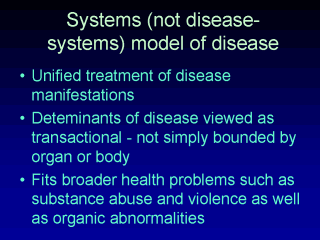| front |1 |2 |3 |4 |5 |6 |7 |8 |9 |10 |11 |12 |13 |14 |15 |16 |17 |18 |19 |20 |21 |22 |23 |24 |25 |26 |27 |28 |29 |30 |31 |32 |33 |34 |35 |36 |37 |38 |review |
 |
The systems model
of disease is perhaps the closest view of disease the west has developed to that of the
underlying premise of Traditional Chinese Medicine. It might be thought of as an holistic
or integrated view that considers a series of systems, from the lowest levels of
organization, molecular, up to the highest levels, nations or countries, perhaps. These
systems are recognized to be embedded, that is they have contexts or settings within which
they function; the environment; physical, cultural, psychological, social, biological,
geographic, political and economic contexts. A second feature of systems models of disease is that they are transactional. That is they assume different levels or components of different systems interact with one another in complex ways, and that these interactions in turn create further complex phenomena, such as disease. This model explains many contemporary health problems we see, including violence, crime, domestic abuse, substance abuse, as well as epidemics, such as those of HIV/AIDS and cancers and heart diseases for example. In other words, the system model is better at accounting for the phenomena we see in the real world than is the 19th century mechanistic model of disease that still dominates medicine today. |